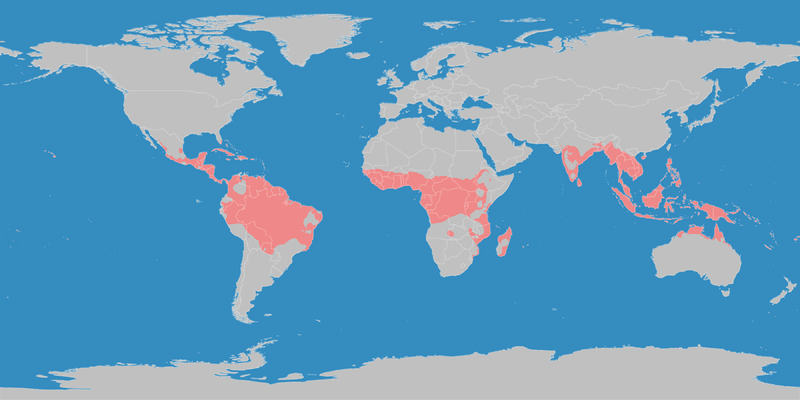The tropical rainforest

Characterisatics
- Location
- on both sides of the equator, mostly up to the 10° latitude
- Minimal precipitation
- 1800 - 2000 mm (9,5 - 12 humid months)
- Soils
- most nutrient-poor soils in the world
The tropical rain forest suffers from nutrient scarcity, despite a sumptuous growth and a rapid
decomposition. Why?
In the Tropics the precipitation and temperatures have been high for millions of years. Therefore, the
soils have undergone a more rapid decomposition of the minerals (acceleration of the chemical processes by higher
temperature) and seepage of nutrients (by high precipitation). The soils are therefore predominantly poor in
nutrients.
Nutrients, which are used for plant growth, are to a large extent contained in the existing plant
mass of the rain forest. By the high temperatures, growth as well as decomposition processes are accelerated. If
plant parts die (a branch breaks, leaves fall off, roots rot), these nutrients are rapidly taken up by other plants.
This cycle keeps the nutrients "home" in the rain forest and "shields" them from being washed away.
Problems
arise if this cycle is interrupted. This may occur through human intervention, by clearing the land for wood or food
production, or mark territorial claims in the rain forest. More harmful than the withdrawal of individual plants is
the destruction of the ground cover; the missing "filter", which takes up nutrients through their roots rapidly
again. Until these "filter" plants regenerate, nutrients may have already been washed away by the plentiful rain
into lakes, rivers and into the sea - unreachable for the plants.
This happens possibly through clearing. Wood
is a valuable good and therefore the export of tropical woods may be a profitable business. The nutrients contained
in the trees are now missing in the rain forest.
The second, still larger problem is the slashing and burning.
The rising number of inhabitants of tropical countries seek land in the rain forest to grow their food. The surfaces
are partly cleared by fire. Since the soils contain so few nutrients, and since nutrients are more rapidly washed
away when plant cover is thin, the soils become useless for farming after few years. Then, the inhabitants move
further. In order to feed themselves, they clear new surfaces in the forests.
The burning down of the rain
forest causes the loss of an important part of the nutrients which were present in the plants, as well as the
ability to protect the freed nutrients with the roots from rapid washing-away. Thus, a rapid loss of the soil
fertility is caused and makes the soils almost infertile after a few decades of such management. On such soils,
plants find it increasingly hard to grow. A gradual formation of savannahs or even deserts may occur.
Amazonia
Example: Manaus - the capital of the state of Amazonas
Because of the nearness to the equator (3° southern latitude), the seasonal course knows only low changes in the daylength. Therefore, only drying time and rainy season are distinguished at place of four seasons. Here, a humid-tropical climate rules, that is all year round it is hot and the air is very humid. During the rainy season, from December to May, strong showers come down almost daily. The amount of precipiation per year reaches more than 2000 millimetres, what corresponds to the double to triple of the value achieved in Germany. At night, the air humidity amounts to at least 95% and is also often very high during the day, so that the air temperature is perceived by people as even warmer than it is actually. The average temperatures of the single months of one year varies only weakly between 26 and 28°C. The maximum temperatures mostly lie between 30 and 40°C, while at night temperatures only reach between 20 and 30°C.



